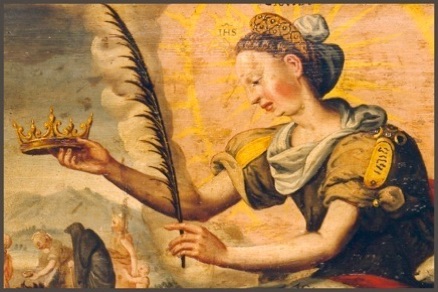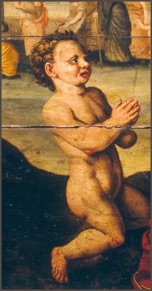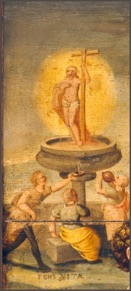Panel
Vos, Maerten de (1532-1603), region of South Netherlands, Antwerp.
Gratia (Grace) at the river of life. 1550-1600. Grace (Gratia) seated, offers a naked, kneeling figure the crown of eternal life and a palm leaf; on her lap an open book on which is written: Agnus occisus, Apocalypsis 6, while the Lamb of God opens the closed book with 7 seals. Further on Christ as the Fons Vitae (the river of life) whence both old and young drink from the waters of eternal life. On its acquisition in April 1918 ascribed to Ernst Maeler of Kampen (1500-1573). Acquired from the Nanninga Uiterdijk collection, from H. Suskind & Son., Denekamp, April 1918.
This painting on panel is a striking mixture of classical and Christian motifs. In the foreground we see how a child, presumably Christ, is crowned by the heathen woman Gratia, in this case best explained as a personification of divine mercy. On her lap lies the book with the ’seven seals’, described in the Biblical Book of Revelation. The lamb, which according to this passage is the only one who can break the seals, has its legs on the open page where we read: ’Agnus occisus. Apoc. 6’ (’The lamb that is slaughtered. Apocalypse 6’). Gratia gives the boy a crown, symbol of earthly and heavenly sovereignty, and a palm leaf, symbol of victory. The first attribute is mentioned in Revelation 6; both probably refer to Christ’s victory over death. As Jesus is often called the ’Lamb of God’, here he is portrayed twice: once as a baby and once as a lamb. And he even appears a third time, since in the far background he is standing with the cross in his hands in the ’fons vitae’ or the ’river of life’. The Book of Revelation tells us that people both young and old hastened to this holy place, as indeed portrayed in this painting.
Paneel
Vos, Maerten de (1532-1603), omgeving van Zuid-Nederland, Antwerpen
Gratia (de Genade) bij de bron des levens. 1550-1600
De Genade (Gratia) neergezeten reikt een naakt geknield figuur de kroon van het eeuwige leven en een palmtak; op haar schoot een opengeslagen boek waarop: Agnus occisus, Apocalypsis 6, terwijl het Lam Gods het met 7 zegels gesloten boek opent. Verderop Christus als de Fons Vitae (de levensbron) van waaruit oud en j ong het water van het eeuwige leven schept.
Bij verwerving in april 1918 toegeschreven aan Ernst Maeler te Kampen (1500-1573). Verworven uit de collectie Nanninga Uiterdijk, bij H. Suskind en Zn., Denekamp, april 1918.
Dit schilderij op paneel is een merkwaardige mengeling van klassieke en christelijke motieven. Op de voorgrond zien we hoe een kind, vermoedelijk Christus, gekroond wordt door de heidense vrouwe Gratia, in dit geval het best uit te leggen als een personificatie van de goddelijke genade. Op haar schoot ligt ‘het boek met de zeven zegels’, waarvan in het bijbelboek Openbaring sprake is. Het lam dat volgens deze tekst als enige de zegels kan breken, houdt de poten op de opengeslagen bladzijde waarop te lezen staat: ‘Agnus occisus. Apoc. 6’ (’Het lam dat geslacht is. Apocalyps 6’). Gratia geeft de jongen behalve een kroon, teken van aardse en hemelse soevereiniteit, een palmtak, symbool van overwinning. Het eerste attribuut wordt genoemd in Openbaring 6, beide verwijzen waarschijnlijk naar Christus’ overwinning op de dood. Aangezien Jezus vaak ‘het Lam Gods’ genoemd wordt, is hij hier dus tweemaal afgebeeld: eenmaal als baby en eenmaal als lam. En zelfs een derde maal komt hij voor, want helemaal op de achtergrond staat hij met het kruis in de handen in de ‘fons vitae’ of de ‘bron des levens’. Over deze heilzame plaats meldt de Openbaring dat jong en oud zich ernaar toe reppen, zoals inderdaad ook op dit schilderij het geval is.







